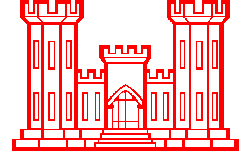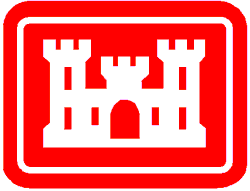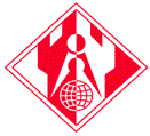Corps Insignia
The Corps of Engineers has had a long and colorful history. This is evident in the insignia that have evolved since the early 1800s. Many have been designed to highlight different aspects of the Corps' tradition and history. The various Corps insignia that are widely used today, are presented here.
Turret Castle


In 1840, the Army officially announced the adoption of the turret castle, which was the insignia to be worn on the Corps of Engineers uniform epaulets and belt plates. Although the design of the castle has changed many times since its inception, it has remained the distinct symbol of the Corps of Engineers. The design represents a castle in its most conventional form, without decoration or embellishments, to secure simplicity of the design and practicality in use.The castle has evolved into two styles that are used today, the traditional and the signature. The traditional castle is used for external Corps communications and identification application where there is a need for traditional heraldry. The signature castle, created in 1981, is used to graphically identify the Corps and its Field Operating Activities in a uniform and communicative way.
Corps of Engineers Seal
 The official Corps Seal is sometimes referred to as the Coat of Arms. It was adopted shortly after the Civil War to commemorate the consolidation of the Topographical Engineers with the regular Corps of Engineers. The significance of the design as commemorating the achievements of both the Corps of Engineers and the Corps of Topographical Engineers is plain to see. The larger shield is divided into three horizontal sections, of which the top is represented in solid blue while the bottom is divided into vertical red and white stripes. The center section shows the original shields of the two historic Corps organizations--the dexter shield being a reproduction of the basic device of the Engineer's oldest insignia, the Essayons Button; and the sinister shield showing the Corps of Topographical Engineers' red, white, and blue shield between the "T" and "E". This seal was not adopted officially by the Corps of Engineers until 1897.
The official Corps Seal is sometimes referred to as the Coat of Arms. It was adopted shortly after the Civil War to commemorate the consolidation of the Topographical Engineers with the regular Corps of Engineers. The significance of the design as commemorating the achievements of both the Corps of Engineers and the Corps of Topographical Engineers is plain to see. The larger shield is divided into three horizontal sections, of which the top is represented in solid blue while the bottom is divided into vertical red and white stripes. The center section shows the original shields of the two historic Corps organizations--the dexter shield being a reproduction of the basic device of the Engineer's oldest insignia, the Essayons Button; and the sinister shield showing the Corps of Topographical Engineers' red, white, and blue shield between the "T" and "E". This seal was not adopted officially by the Corps of Engineers until 1897.
Essayons Button
 The Essayons Button is the Corps' oldest and most time-honored insignia. The basic design on the Engineer Button shows the masonry of the bastion of a marine battery, embrasures, casemated and crenelated, surrounded by water, a rising sun with rays, all surmounted by a soaring eagle bearing in its beak a streamer displaying the motto "Essayons." This distinctive button is exclusive only to the Army Corps of Engineers. The Corps of Engineers is the only branch of the Army where the officers are permitted to wear decorative buttons. The other branches wear the standard service button.
The Essayons Button is the Corps' oldest and most time-honored insignia. The basic design on the Engineer Button shows the masonry of the bastion of a marine battery, embrasures, casemated and crenelated, surrounded by water, a rising sun with rays, all surmounted by a soaring eagle bearing in its beak a streamer displaying the motto "Essayons." This distinctive button is exclusive only to the Army Corps of Engineers. The Corps of Engineers is the only branch of the Army where the officers are permitted to wear decorative buttons. The other branches wear the standard service button.
Official Unit Crest
 Each military unit has its own unit crest, including the Corps of Engineers. The eagle, our national symbol, stands behind the scarlet and white tower representing the Corps of Engineers and its construction mission. The worldwide scope of the Corps' mission and its service to the Nation in the past, present and future area is suggested by the sun symbol and the globe. The olive branch signifies the peaceful nature of the Corps' mission and the oak stands for fortitude. Also, the branch symbolizes the Corps' concern for the environment. The Corps' historic motto, "Essayons," meaning "let us try" is held in the eagle's beak.
Each military unit has its own unit crest, including the Corps of Engineers. The eagle, our national symbol, stands behind the scarlet and white tower representing the Corps of Engineers and its construction mission. The worldwide scope of the Corps' mission and its service to the Nation in the past, present and future area is suggested by the sun symbol and the globe. The olive branch signifies the peaceful nature of the Corps' mission and the oak stands for fortitude. Also, the branch symbolizes the Corps' concern for the environment. The Corps' historic motto, "Essayons," meaning "let us try" is held in the eagle's beak.
Uniform Insignia
 All major commands and divisions of the Army have their own uniform patches. As a Major command, the Corps of Engineers implements the traditional scarlet and white color on their uniform patch. The globe refers to the activities of Engineering Divisions and Districts, both in the continental United States and overseas. The dividers are symbolic of design and planning, and the tower signifies the construction mission.
All major commands and divisions of the Army have their own uniform patches. As a Major command, the Corps of Engineers implements the traditional scarlet and white color on their uniform patch. The globe refers to the activities of Engineering Divisions and Districts, both in the continental United States and overseas. The dividers are symbolic of design and planning, and the tower signifies the construction mission.
Corps Legal Services
 In May 1988, a new insignia was issued for the Corps of Engineers Legal Services. The idea for this insignia was from the efforts of the Career Management Committee to provide greater recognition for all Corps attorneys. At the heart of the symbol is the traditional Engineer castle, in scarlet, representing the focus and purpose of our legal services. The castle is superimposed on the scales of justice and military sword symbolizing Counsel's broader duties to the Army and the legal foundations of our Nation. The scales are balanced to signify our dedication to justice and equality before the law. The deep purpose background indicates our unwavering commitment and fidelity to the client's interest bounded by an unbroken circle of black representing the solemn oath of integrity and professionalism. The two pentagonal stars signify excellence and accountability. The words "Legal Services" embrace all attorneys who serve the Corps mission. (Reprinted from "Riverviews" Ohio River Division)
In May 1988, a new insignia was issued for the Corps of Engineers Legal Services. The idea for this insignia was from the efforts of the Career Management Committee to provide greater recognition for all Corps attorneys. At the heart of the symbol is the traditional Engineer castle, in scarlet, representing the focus and purpose of our legal services. The castle is superimposed on the scales of justice and military sword symbolizing Counsel's broader duties to the Army and the legal foundations of our Nation. The scales are balanced to signify our dedication to justice and equality before the law. The deep purpose background indicates our unwavering commitment and fidelity to the client's interest bounded by an unbroken circle of black representing the solemn oath of integrity and professionalism. The two pentagonal stars signify excellence and accountability. The words "Legal Services" embrace all attorneys who serve the Corps mission. (Reprinted from "Riverviews" Ohio River Division)
This site is a public service of the Portland District, U.S. Army Corps of Engineers, for use by the public to view and retrieve information only. Unauthorized attempts to upload or change information on this service are strictly prohibited and may be punishable under the Computer Fraud and Abuse act of 1986. All information on this site is considered public information and may be distributed or copied. Inquiries can be forwarded to the contact listed in the individual documents or may be e-mailed to cenwp-pa@usace.army.mil.
